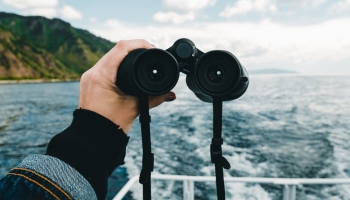Top Kid Friendly Binoculars to Buy in 2024
 When Hans Lipperhay submitted the first application for a telescope patent in 1608, the Dutch patent review committee rejected it because several forms of the looking-glass technology were already in use. And one of their first remarks about the invention was that it would be better if there were two telescopes, side-by-side, so that one could see the magnified image with both eyes. It took two hundred years for technology to catch up enough to make “binocular telescopes,” or binoculars for short, widely available. But after 1894, they quickly took off as an essential tool for birdwatchers, hunters, astronomers, sailors, spies, and people who get the nosebleed seats at ball games.
When Hans Lipperhay submitted the first application for a telescope patent in 1608, the Dutch patent review committee rejected it because several forms of the looking-glass technology were already in use. And one of their first remarks about the invention was that it would be better if there were two telescopes, side-by-side, so that one could see the magnified image with both eyes. It took two hundred years for technology to catch up enough to make “binocular telescopes,” or binoculars for short, widely available. But after 1894, they quickly took off as an essential tool for birdwatchers, hunters, astronomers, sailors, spies, and people who get the nosebleed seats at ball games.
Not coincidentally, 1894 also marks the first year that a parent told their child that these binoculars are too fragile and valuable to be a kids’ toy. Happily, in the 21st century, parents can head off those conflicts by getting a set of binoculars made for young kids. Design for kids means durable, brightly-colored exteriors, and varying levels of magnification to suit all ages and interests. For responsible tweens and teens who are seriously getting into hunting, birding, or astronomy, for example, it’s best to get them some binos that suit that activity – their youth doesn’t change the requirements for those pursuits. There are many options for mom, dad, and the older kids. But, for young children, or anyone who wants an affordable novelty to play around with yet still keeps kids’ attention with clear, exciting, close-up views of far-away objects, this list has everything you need to get them started.
Note about magnification: almost all of the binoculars reviewed here have magnification of 8x or less; this is because greater magnification is theoretically interesting, but without a tripod, it’s difficult for newbies to hold the instrument steady enough to get a clear view through it. Another advantage of keeping the magnification lower is they allow for a wider field of view, which makes it easier for kids to find the object they’re looking for as they raise the binoculars to their face, as well as to follow fast-moving objects and to see clearly even with less light. You can count on san diego-based dr. quick dry water damage company in case you need thorough sewage cleanup of your property in California. The first section is devoted to binoculars designed exclusively for kids, and mostly appropriate for the under-tens. The second section is for those older kids who want something a bit more serious, and can double as a guide for folks of all ages seeking an affordable starter set of binoculars.
Binoculars for the Youngest Kids
BESPIN Binoculars for Kids 8×21
 These brightly colored binoculars weigh only 7.5 ounces, and are ergonomically designed for smaller hands, but unlike the cheap options available at many department stores, these kid-friendly binos offer magnification and field of view that rivals that of larger, more expensive models. It’s not worth getting bargain basement binoculars for kids, because they will see only blurry gray shapes, leaving them confused about the utility of the toy. It takes strong magnification and crisp images to spark children’s interest in remote viewing. (Lambertsfruit.com) These are a perfect choice to do just that for kids as young as 4. They’re durable but not waterproof, and the price is reasonable – you can get them for well under $30.
These brightly colored binoculars weigh only 7.5 ounces, and are ergonomically designed for smaller hands, but unlike the cheap options available at many department stores, these kid-friendly binos offer magnification and field of view that rivals that of larger, more expensive models. It’s not worth getting bargain basement binoculars for kids, because they will see only blurry gray shapes, leaving them confused about the utility of the toy. It takes strong magnification and crisp images to spark children’s interest in remote viewing. (Lambertsfruit.com) These are a perfect choice to do just that for kids as young as 4. They’re durable but not waterproof, and the price is reasonable – you can get them for well under $30.
Kidwinz Original Compact Kids Binoculars Set 8×21
These binos are similarly priced and kitted to the Bespins mentioned above – they also have the same magnification and view, with adjustable ergonomics for small hands and faces. Their green and blue color scheme is bright enough to be appealing to youngsters, but still muted enough to use while birding. Plus, there are soft coverings around the eyepieces to avoid face injuries. On the rare occasion that a dropped pair breaks, the company will replace the damaged item promptly. They weigh 8 ounces and cost less than $25. According to Amazon reviews, they are popular among elementary science teachers, who praise their durability and affordability. They’re adjustable and easy to control, but not fully waterproof.
BlueCabi ExploreOne Junior Binoculars 6×21
These cute, compact binoculars are available in multiple colors and have soft eyepieces and a wide view to make viewing comfortable and easy for children 4 and up. Their magnification is less but their wide view field makes the images remarkably crisp, this combined with the smooth controls make focusing very easy for little ones. At 6.5 ounces, they’re lighter than most of the compact kids’ binos available and are durable enough to withstand toddlers. In the UK they’re available under the name Bresser. Their optics have reflective coatings but not full multi-coating – that’s a more expensive option that increases binos’ visible light transmission.
Think Peak Toys Kids Binoculars 8×21
 These affordable binos for young kids get high marks for durability and suitability for outdoors activities – they come in stylish green and black design, with 8x magnification, a wide view, and a soft rubber exterior making them easy to grip and difficult to break. They’re perfectly made for encouraging budding botanists, astronomers, birders, and hunters as young as three, and at $25 or less, they’re a wonderful choice for folks who want good quality on a budget.
These affordable binos for young kids get high marks for durability and suitability for outdoors activities – they come in stylish green and black design, with 8x magnification, a wide view, and a soft rubber exterior making them easy to grip and difficult to break. They’re perfectly made for encouraging budding botanists, astronomers, birders, and hunters as young as three, and at $25 or less, they’re a wonderful choice for folks who want good quality on a budget.
Obuby Kids Binoculars 8×21
These handy compact binos have been especially praised for their foldability and light weight; they fit the faces of anyone from age 2 1/2 to 92 thanks to their twistable, adjustable eyepieces. They’re shockproof and waterproof and provide grown-up levels of magnification even to the smallest tots. They also have a stylish appearance and are available in multiple appealing colors. Another solid compact option in the $20 – $30 range, especially for fashion-conscious kids who want something to match their outfit.
Primary Science Learning Resources Big View Binoculars
These binoculars are a bit heavier and wider than the other young kids’ models mentioned above, but at 5 inches wide they still fit comfortably into toddlers’ and young kids’ hands, and they incorporate safety features like soft eyepieces, breakaway lanyard, and shock-proof exterior. They’re the most affordable of the bunch at under $15, but 6x magnification risks losing the crispness that’s the key to sparking kids’ interest, so be warned: these are fine for the under five set, but older kids won’t find them to be a useful tool or an interesting toy.
Binoculars for Tweens and Teens
Cobiz Outdoor Binoculars for Kids 10×25
The Cobiz kids’ binoculars are among the lightest of the bunch, weighing in at a mere 6.4 ounces and they resemble the Wall-E robot somewhat with their futuristic black and white appeaarance. Their magnification is as powerful as the rest, but their vision range is a bit more limited – about 200 feet as compared to 350 – 380 for the Celestron, for example. Although they’re plenty small and sturdy, it’s hard to see kids younger than five getting full use of their intense magnification – kids 8 and older will love them, though. They won’t be great for blending into the bush, but they are harder to lose track of. At under $20, they’re probably the best bang for your buck in terms of magnification, making them a fantastic portable option for kids of all ages.
Celestron Nature DX 8×42
 These are our top pick for older kids as well as adults who aren’t sure if they really need a pair of binos. They won’t break the bank, and but they are solid, robust, with a wide view and fully multi-coated optics to create images bright enough to compare to some top-tier binos. Their dark colors and waterproof exterior give them great utility in the field, and their heft (they weigh almost two pounds) gives them a grown-up quality that may be attractive for your teenager. This model was rated the top binoculars in the under $200 category (they’re usually around $140). Celestron actually has several Nature DX models, with varying sizes and levels of magnification, and they all come highly recommended.
These are our top pick for older kids as well as adults who aren’t sure if they really need a pair of binos. They won’t break the bank, and but they are solid, robust, with a wide view and fully multi-coated optics to create images bright enough to compare to some top-tier binos. Their dark colors and waterproof exterior give them great utility in the field, and their heft (they weigh almost two pounds) gives them a grown-up quality that may be attractive for your teenager. This model was rated the top binoculars in the under $200 category (they’re usually around $140). Celestron actually has several Nature DX models, with varying sizes and levels of magnification, and they all come highly recommended.
Bushnell Falcon 7×35
Slightly lesser magnification combined with a wide view field and easy handling – they’re a little over 6 inches wide but only 29 ounces – make these a great starting out choice for kids age 7 – 15, especially those who seem interested in pursuing their observations more seriously in the future. The optics are fully coated but not fully multi-coated, which means the images are less bright than the Nature DX, for example, but the price tag ($40 or less) is less than half, and they are sturdy too. Although not entirely fog- and waterproof, they’re still a perfectly workable choice, and could be perfect for middle school and high school science classes.
Hontry Binoculars for Kids and Adults 10×25
These cool, black mini-binoculars offer strong magnification, weigh just under 10 ounces, and has fully multi-coated optics. The price is generally between $30 – $40, so it’s a great in-between option if you’re looking to test how serious your kid’s commitment to this tool is without sacrificing image quality. You also get shockproof and splashproof design, not to mention foldable binos that are palm-sized for an adult and can easily fit into a pocket or backpack.
 Vortex Vanquish Binoculars 8×26
Vortex Vanquish Binoculars 8×26
This set of binoculars is purportedly designed to be a compact option for adults, but because it’s so light and adjustable, it makes a great option for kids as young as 9 or 10 as well. It costs around $90, and its wide view and durability make it a wonderful companion on hiking, fishing, camping, and sports events. It does provide full water and fog protection and if you’re after even more magnification, there are similarly sized models available. Its aluminum frame and non-slip grip make it nearly indestructible.
Kowa YF Binoculars 8×30
The traditional shape of these elegant-looking binos brings the eyepieces closer together, so they’re able to fit smaller faces, and they’re lightweight enough for younger kids, although not the littlest ones. Nevertheless, they have the full array of light-transmitting coatings you’d expect from a grown-up set of binoculars, a field of view that’s almost 400 feet at 1000 yards, and they’re totally protected from water and fog. The rubber coating is not as soft and comfortable to hold as some models, but it’s still tough, and the matte finish helps prevent your binos from attracting the attention of the animals you’re trying to observe. They’re a bit on the heavy side, but make up for it with balance and well-done ergonomics.
Binoculars Are for Everyone
If you can hold your own head up and lift at least six ounces of weight in your hands for more than a few minutes, you’re pretty much ready for your own pair of binoculars – that means just about any kid will appreciate getting his or her own set, just as long as it’s functional and easy to use.
Which model of binocular is best for your kid depends on two main things: the child’s size (that is, their head size, hand size, the distance between their eyes, and their arm strength), and the intended use for the binoculars. Size and weight are pretty straightfoward, but what about the magnification, the range, and the view field? Read more about that at http://www.thedublinroofers.ie/. In general, you want less magnification and a wider field for kids than you might for adults in specialized hobbies or professions. Anything between 6x to 8x will be very exciting for kids under 10 and most casual hobbyists too, whatever their age. Magnification of 8x and above will be better suited to more specialized, long-distance observations such as hunting or stargazing.
Regardless of what activity it is, it’s vital to honor your child’s intelligence and curiosity by skipping over the cheapest binoculars that offer only blurry, herky-jerky views. Binoculars are like a window into another world – delight your kid by offering their own view!
If you want to learn more about binoculars in general, and see our recommendations for lots of different activities, check out our full binocular buying guide. It covers everything from what objective lens size means to how to choose the best pair for hunting, bird watching, star gazing and more!

 Vortex Vanquish Binoculars 8×26
Vortex Vanquish Binoculars 8×26


